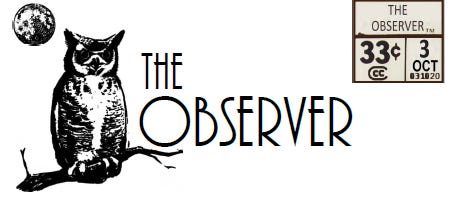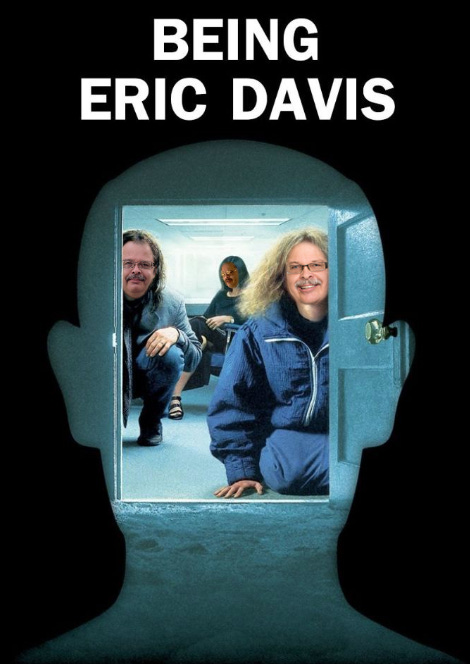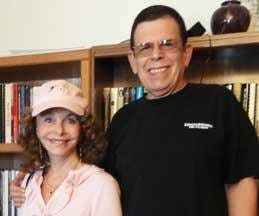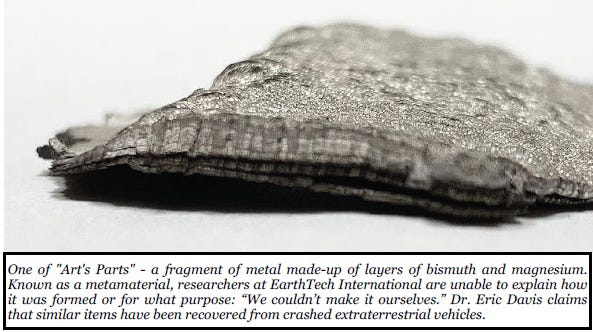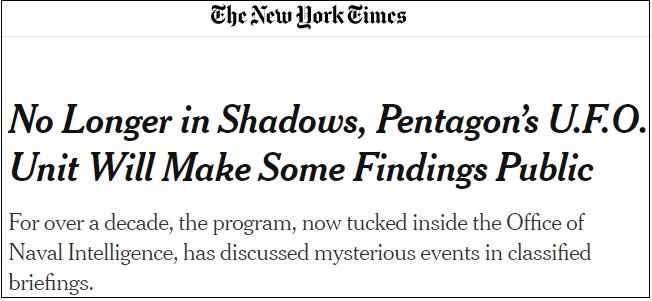Click Here for Part 1
Davis' Wilson Memo Core Document Secret Leak
Despite his impressive credentials, some view Dr. Eric Davis as a polarizing figure. One of his biggest controversies stems from an incident known as the “Davis/Wilson Memo,” or the “Core Secrets Document,” or depending on your source, any other conceivable combination of those words. Back in 2002, when his time with Bigelow’s NIDS was coming to a close, and before we went to work for EarthTech or BAASS, Eric Davis was allegedly in Las Vegas for a meeting with an important member of the Defense Intelligence Agency. This individual, Vice Admiral Thomas Wilson, supposedly sat with Dr. Davis for close to an hour in the backseat of a car, discussing the Admiral's knowledge about the government’s research and recovery of anomalous flying objects. There was just one problem with the rumored meet up - the Admiral’s recollection of the events. “It’s all fiction,” Admiral Wilson told a reporter when asked recently about the alleged sit down with Davis. “I wouldn’t know Eric Davis if he walked in right now … I don’t remember him, and I definitely did not sit with him in a car for an hour in Las Vegas.”
The unverified encounter in Nevada was in response to a different, confirmed meeting that took place at the Pentagon five years prior, in 1997, between the Admiral and a small group of Disclosure advocates (including the controversial Steven Greer and NASA astronaut Edgar Mitchell). The purpose of the original 1997 meeting was to clue Admiral Wilson in to the presence of covert programs within the federal government dealing with unidentified flying objects.
They were pinning their hopes for further UFO information on Admiral Wilson’s indignation at not being “in the know” on these Special Access Programs (SAPs) that should have been well within his domain at the DIA. After providing the Admiral with the official code names for these initiatives, the group later claims to have received a follow up message from him, indicating that he was stonewalled and prevented from learning anything about the programs' existence or objectives. The Admiral, however, denies communicating with the group after their initial 1997 meeting, explaining that their stories about clandestine programs hidden within the government did not sound credible enough to pursue any further.
Fast forward to 2002 and the infamous meeting in Vegas between the Admiral and Eric Davis. As the disputed version of the story goes, Davis took copious shorthand notes of their backseat chat, which later amounted to 12 typed pages. They include the Admiral's confirmation of the existence of deep-black UFO projects, along with an admission that he had been blocked from obtaining additional information. Soon after, rumors began circulating about the potential written play-by-play of their encounter, and in 2019 Dr. Davis’ notes mysteriously found their way onto the internet, where they were widely accepted as authentic. In the estimation of one respected UFO historian, Richard Dolan, these documents constitute the “leak of the century.”
For his part, Eric Davis has offered a few “no comment” replies to questions about any 2002 rendezvous with Wilson or the notes that have surfaced. Meanwhile, Admiral Wilson maintains that the 2002 meeting never took place.
One Man's Trash...
So how did Eric Davis, someone with close associations to the “UFO-crowd,” who spent years hunting wormholes on a haunted ranch in Utah, end up being quoted as an authority in the New York Times about deeply classified, top-secret government information? Those threads come together through his involvement with an initiative known as The Acquisition & Data Analysis of Materials Research Project (ADAM).
The ADAM initiative was started in 2018 by To the Stars Academy to focus exclusively on “the collection and scientific evaluation of material samples obtained through reliable reports of advanced aerospace vehicles of unknown origin.” Put simply, the group was tasked with obtaining pieces from UFOs and evaluating them for potential uses. TTSA then contracted with – you guessed it! – Hal Puthoff’s EarthTech International for technical assistance on ADAM, thus ensuring Dr. Davis’ involvement in the analysis of any recovered materials.
Shortly after publicly revealing the ADAM Project, the investigative team got their hands on some strange metallic fragments that were purportedly gathered from crashed aerial vehicles. In a promotional video put out by To the Stars Academy, Hal Puthoff is shown handling the wrapped objects with extreme care after they’d been securely delivered to his office in Austin, Texas. For just a few frames, Eric Davis is caught on camera, already scrutinizing the evidence over Hal’s shoulder while wearing one of his signature Hawaiian shirts.
Despite the encouraging start to Project ADAM, it wasn’t long before more details emerged that began to cast doubt on the veracity of the metal samples they had acquired. Instead of being a revolutionary new substance, the palm-sized wedges of metamaterial were composed of known elements: layered bismuth and magnesium. Further information about the pieces soon made it clear that the same fragments had actually been in circulation since the 1990s. In fact, Dr. Harold Puthoff and EarthTech International had studied the objects in the past – twice!
The mysterious metamaterials were first introduced in 1996 by the patriarch of paranormal talk radio – Art Bell. He claimed to have received them in the mail from an anonymous sender, along with other unidentified metal objects reportedly taken from a crashed extraterrestrial craft. The letter accompanying the items outlined a questionable chain of custody, explaining how they were initially recovered by the author’s grandfather in 1947. He was allegedly part of a military retrieval team that responded to a downed alien “Disc” in the Roswell desert. It was a dubious narrative and hard to corroborate, but there were enough curiosities about some of the slag fragments (known colloquially as “Art’s Parts”) to keep them in rotation as a topic of discussion for years. Through Art Bell, portions of the substance made their way into the hands of a famous paranormal investigative journalist, Linda Moulton Howe. Linda later sent small samples to Puthoff, Davis and EarthTech in 1999 for a deeper analysis. She hoped that his company would be able to shed some light on their unique composition and properties. After only a few months in Hal’s possession, they were returned to Linda with no conclusive information or added insights.
Many years later, in 2012, Hal and Linda decided it was time to retest the anomalous objects in EarthTech International’s expanded and updated lab. Linda also managed to obtain a larger piece, which they thought might aid their experiments. This time, the focus was on subjecting the material to various magnetic fields in order to generate a “lifting body.” In other words, if the metamaterials actually did come from an unidentified flying object, the duo wanted to see if they could get them to defy gravity through various unconventional means. Just like their collaboration 13 years prior, the results of the 2012 controlled experiments were underwhelming, and according to Puthoff, “did not yield an interesting/anomalous outcome.” Despite this apparent setback, it would not be the last time these metal pieces would find themselves under EarthTech’s microscope.
Third Time's a Charm...
In 2019, when Project ADAM made the bold announcement that they had secured a “groundbreaking metamaterials acquisition,” observers were more than skeptical. Suspicions were heightened by a press release revealing that the “groundbreaking” objects were merely part of the same old collection sent to Art Bell in the 1990s, and “previously retained and studied by investigative journalist Linda Moulton Howe.” That meant that these items had already been subjected to a battery of tests over the past decades, and despite small questions about where and why it was manufactured, they held few mysteries. Those facts did not stop To the Stars Academy from paying $35,000 for them, presumably from Mrs. Howe - a large sum of money for a few hunks of metal. Their purchase brought the fragments back into the lab of EarthTech and Dr. Eric Davis for another round of testing.
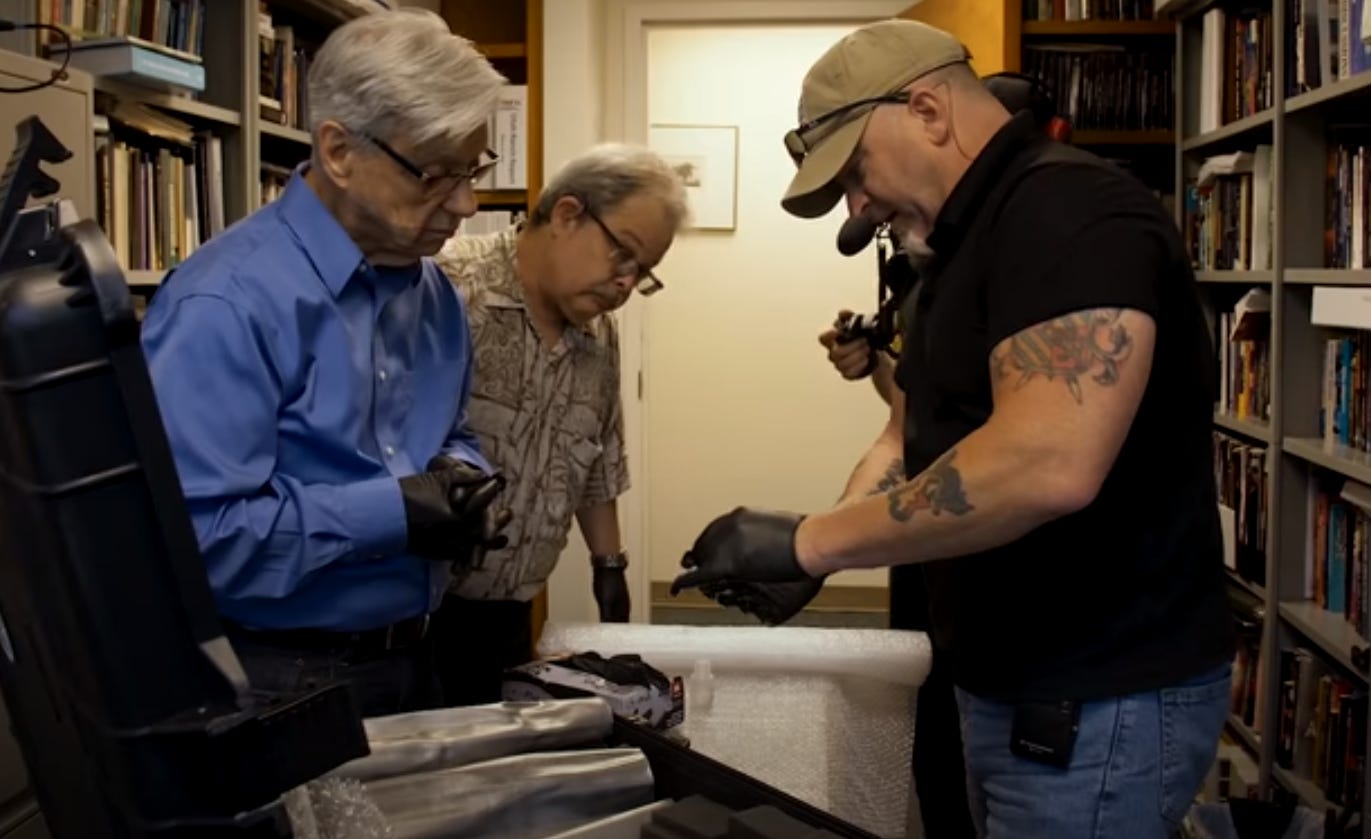
To no one's surprise, Davis and Puthoff’s longtime collaborator, Robert Bigelow, was involved early on in the acquisition and study of the metallic objects. According to the 2017 New York Times exposé (“Glowing Auras and ‘Black Money’: The Pentagon’s Mysterious U.F.O. Program”) about the government’s intense interest in possible extraterrestrial components recovered from suspected crashes, “[u]nder Bigelow’s direction, (his) company modified buildings in Las Vegas for the storage of metal alloys and other materials that … program contractors said had been recovered from unidentified aerial phenomena.” In the end, renewed interest in the metallic fragments, brought about in no small part by TTSA’s media campaign, caught the attention of a game-changing research partner: the United States Army.
Through a non-monetary contract known as a Cooperative Research and Development Agreement (CRADA), the Army and TTSA formalized their shared interest in metamaterials and their potential applications. As part of their arrangement, the Army would provide resources to further the study of the pieces, and TTSA would extend their own subject matter experts to assist with the analysis. This would include both Hal Puthoff and Eric Davis. The Army viewed the partnership as a “non-traditional source for novel materials and transformational technologies;” To the Stars Academy saw it as an additional “path to commercialization;” and Dr. Davis seized yet another opportunity to build his own credibility within the mainstream.
Eric W. Davis added to his standing as a credentialed expert yet again in the Fall of 2019. According to the astrophysicist, he was called upon to give multiple, “classified briefings on retrievals of unexplained objects to staff members of the Senate Armed Services Committee … (and) the Senate Intelligence Committee.” This exposure to high-ranking individuals helped to legitimize his work and solidify his reputation as a quotable, ‘UFO-crowd’ scientist. As recently as March 2020, Davis’ information about off-world vehicle crashes and retrievals was considered valuable enough by the Defense Department to request a classified briefing for one of their agencies. By acting as a liaison and translator between paranormal researchers and data-driven government officials, Davis garnered the experience needed to speak intelligently and with authority on the UFO topic.
The timing was perfect for New York Times journalists Leslie Kean and Ralph Blumenthal, who were continuing their work exposing the programs and people involved in the government’s pursuit of anomalous aerial vehicles. Many of Dr. Davis’ friends saw their words printed in the Times before him. Hal Puthoff was quoted liberally in the original 2017 article that revealed the existence of AATIP. Robert Bigelow was also featured prominently, discussing his convictions about life outside our planet. But the significance of Davis’ revelations in the July 2020 Times article raised the bar and upped the ante for future Disclosure announcements. Left unchallenged and unaltered, his assertion that top intelligence officials have current knowledge of UFO recovery efforts and results, along with pieces of downed craft, reignites the anticipation of forthcoming Senate reports and Task Force findings. The public is also interested and media outlets are scrambling to provide coverage and updates of the ongoing UFO-saga.
Davis has said that he doesn’t like the term “fringe science” and the negative connotations it conjures. The astrophysicist prefers to label incidents that occur on the border of conventional understanding as, “out of the box, cutting edge, or breakthrough science.” That’s Eric Davis’ style, as much as his floral patterned attire – re-framing concepts and theories that are widely discounted and denounced by the mainstream, and making them digestible for mass consumption.





